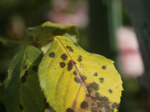Shade
Roses won’t bloom in dense shade. Check they haven’t been overgrown by a tree or shrub. Roses grown against the house wall may be shaded by the eaves as they grow taller. Prune them lower or cut away vegetation around them.
Starvation
If the flowers are small or lose their petals after a day or two, if there aren’t regular spurts of new growth and buds and if the leaves are small and pale, your rose is hungry. Feed it. A scatter of Dynamic Lifter every two weeks or blood and bone or a proprietary rose food dusted over a good mulch. (On the other hand too much nitrogen leads to masses of green leaves and fewer flowers just like a child fed chips and iceblocks will have more than enough calories but never make a champion).
Earwigs
Earwigs love rose buds. Put out crumpled newspaper for the earwigs to shelter in during the day. Every second day stuff the old paper (and its cargo of earwigs) in the rubbish or compost or worm farm and put out new stuff. A thick band of tree grease — or any grease — will stop earwigs climbing up.
Too many rose hips
If you leave the dead flowers and rose hips on the bush there’ll be a long time between rose ‘flushes’ as the bush matures its seed. Prune off roses as soon as they’ve finished flowering — with a little extra as well. This constant mini pruning will stimulate new growth, and masses of blooms. Unless, of course, it’s an old variety that only flowers the once anyway — then you may as well have the hips.
Black spot
This is the rose disease. In mild cases the leaves just look splotchy and ugly; in really severe cases the shoots die back or the rose bush can lose nearly all its leaves and won’t flower either.
Black spot spores over winter, either on those deadish leaves that stay on the bush or on the soil, and incubate when there’s dew or other moisture on the foliage for four hours or more. (This means that in wet or humid weather your rose bushes need umbrellas to stay free of black spot).
Cover the bare soil by spreading with thick mulch every spring or late winter. Prune offall old foliage every winter and spray with Bordeaux spray. There are several commercial fungicides that can be sprayed every three weeks on the leaves during summer.
My response to black spot is to pretend I haven’t noticed the odd yellow and black blotched leaf. But if the bush is dying I spray with one teaspoon bicarbonate of soda mixed into one cup of milk and three cups water, every three days, both under and on top of leaves.
Well fed roses will outgrow black spot — at least most of them will (if you have a black spot prone Bourbon rose like La Reine Victoria, for example, you’ll need to stick it in a raincoat to stop it getting black spot entirely). Take a look at your spotty rose bushes. The old leaves will look awful — but the newest leaves will be unblemished. Remember too that in most varieties the more new growth, the more roses.
Other rose problems
Other rose problems include: root rots (give the bush a shove. If it seems shaky you have a problem), waterlogging, not enough new growth (hybrid tea roses for example bloom on new growth — and if the rose is on a diet it won’t bloom), too much or too little pruning (some roses like Constance Spry flower on last year’s wood; most hybrid teas need the new shoots that are stimulated by regular pruning to give a splashy display).


